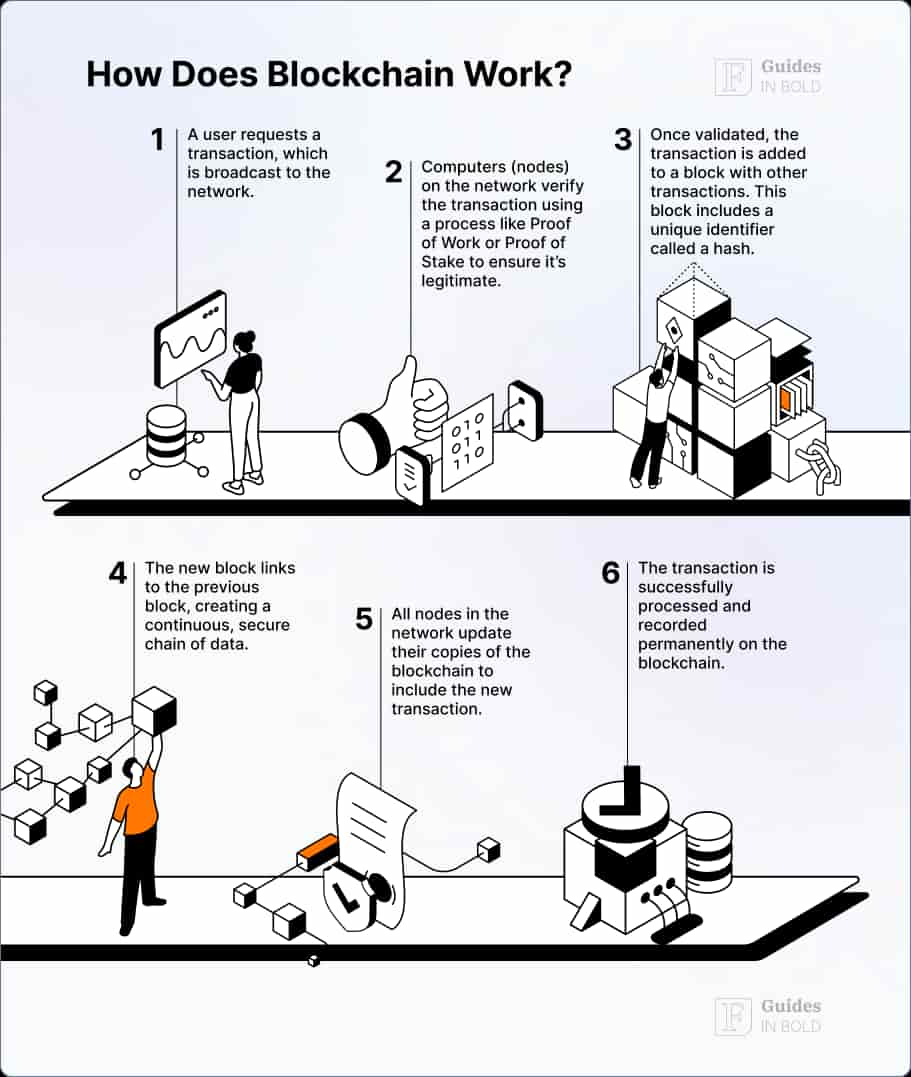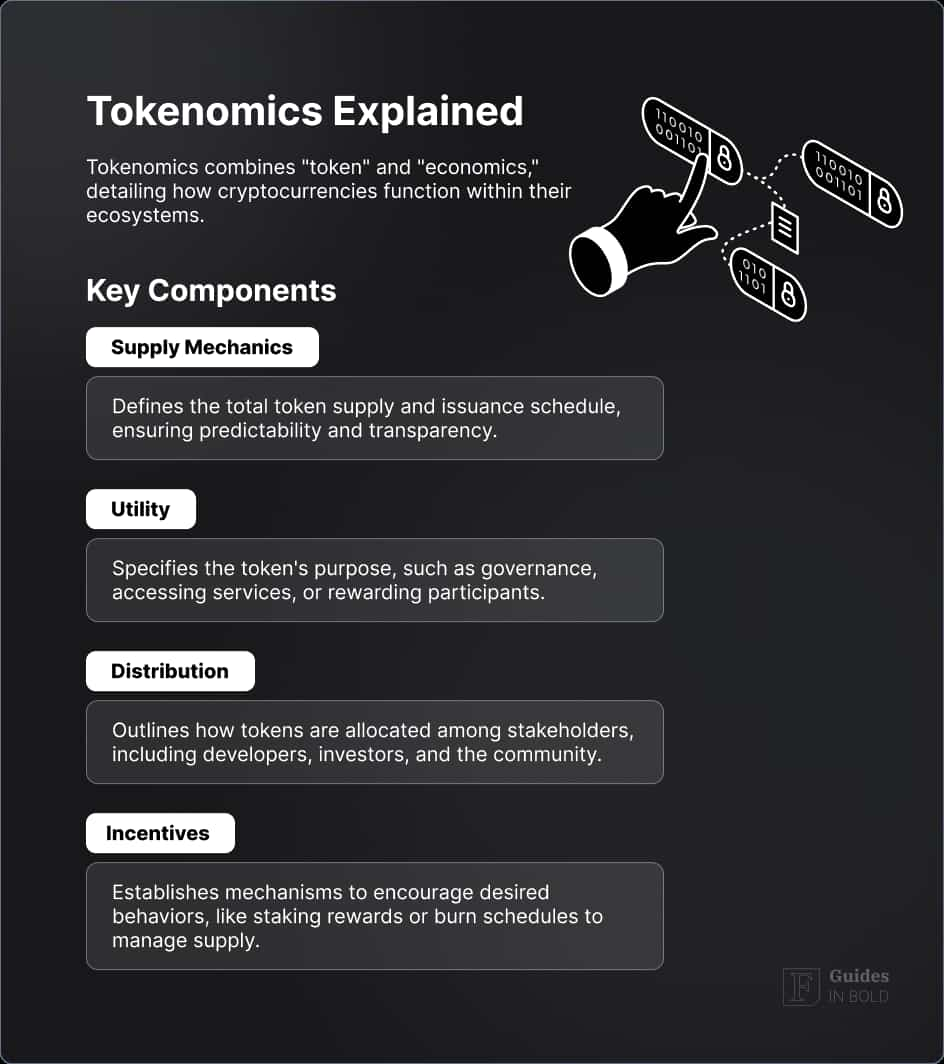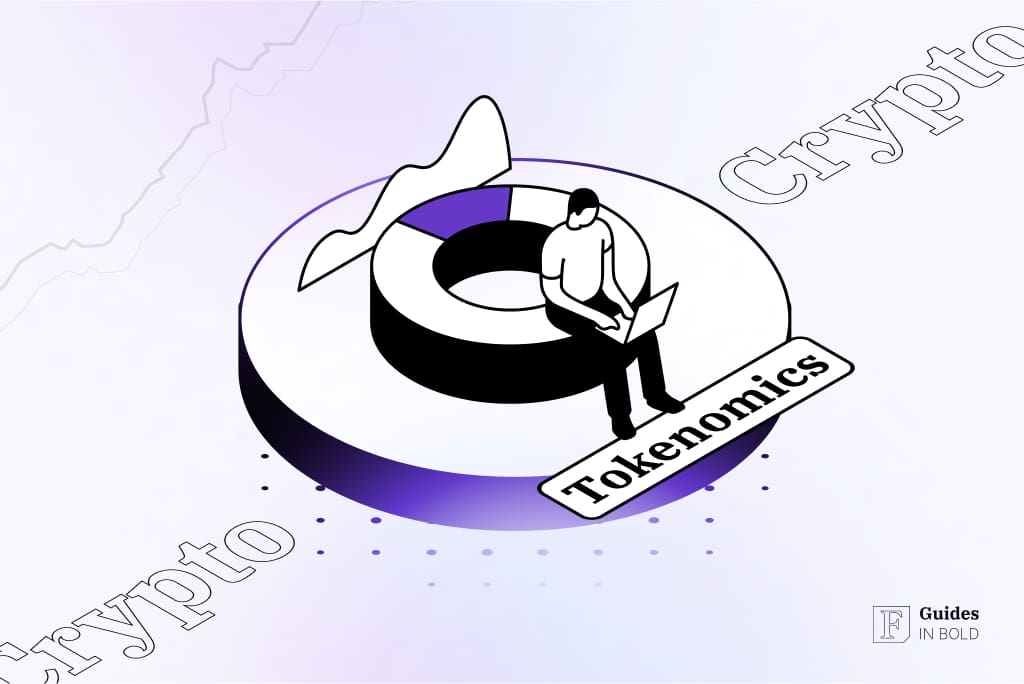IMPORTANT NOTICE
Finbold may provide educational material to inform its users about crypto and digital assets. This content is for general information only and does not constitute professional advice or training certification. Content is provided "as is" without any warranties. Users must conduct their own independent research, seek professional advice before making investment decisions, and remain solely responsible for their actions and decisions.
RISK WARNING: Cryptocurrencies are high-risk investments and you should not expect to be protected if something goes wrong. Don’t invest unless you’re prepared to lose all the money you invest.
By accessing this Site, you acknowledge that you understand these risks and that Finbold bears no responsibility for any losses, damages, or consequences resulting from your use of the Site or reliance on its content. Click here to learn more.
This guide gives a breakdown of tokenomics in crypto to help you understand what it is, how it works, and why it’s important in the cryptocurrency space. It also outlines the fundamentals of what makes effective tokenomics for a cryptocurrency.
Best Crypto Exchange for Intermediate Traders and Investors
-
Invest in cryptocurrencies and 3,000+ other assets including stocks and precious metals.
-
0% commission on stocks - buy in bulk or just a fraction from as little as $10. Other fees apply. For more information, visit etoro.com/trading/fees.
-
Copy top-performing traders in real time, automatically.
-
eToro USA is registered with FINRA for securities trading.
Introduction
Public blockchains are accessible to everyone, including bad actors. Tokenomics helps create trust by aligning the behavior of each actor and strengthening the blockchain protocol.
When a blockchain experiences increased positive behavior from its community, it’s more likely to boost the value of a crypto asset, motivating participants to be good actors.

Crypto token explained
Before we dive into tokenomics, you need to understand what a token means in the crypto space.
Note
Cryptocurrencies and tokens that operate on blockchains are built with pre-set, algorithmically created schedules for issuance. This means people can accurately predict the number of coins that will be available by a particular date.
Even though some crypto assets might alter issuance schedules, it’s usually a difficult process to implement and requires the agreement of the majority of the participants in a particular blockchain. This implies that the tokenomics of a given crypto asset will remain unaltered and predictable, unlike fiat money created by governments. Tokens are divided into different types as follows based on their significance:
- Layer 1 tokens: These tokens are native to a specific blockchain and used for powering all activities on the blockchain;
- Layer 2 tokens: Layer 2 tokens are used in decentralized applications in a particular blockchain network;
- Security tokens: These are investment contract tokens, which must fulfill several conditions, such as money investment, profitability, and common enterprise. A security token must also pass the Howey Test;
- Utility tokens: Utility tokens are useful for financing a network and are issued through an Initial Coin Offering (ICO);
- Fungible tokens: Fungible tokens have the same value together with the facility for replication. An example of a fungible token is ETH tokens on the Ethereum blockchain;
- Non-Fungible tokens (NFTs): These tokens don’t share the same value, making them unique. They are used in the tokenization of digital assets, including pictures, collectibles, or artworks.
What is tokenomics?
In crypto, tokenomics is a collective term used to capture a token’s economics by describing the factors that affect a token’s use and value. Such factors include the token’s creation and distribution, its supply and demand, incentive mechanisms, as well as its burn schedules.
In crypto circles, well-designed tokenomics is important to the success of a cryptocurrency. Investors and stakeholders would need to assess a project’s tokenomics to help them make informed decisions before they participate. Similarly, founder members and developers would need to consider the tokenomics of a native currency carefully before launching a crypto project, as this can contribute to the success of the project and its ability to attract investment.
At the end of the day, projects with good tokenomics are more likely to outlast and perform better than those without smart and well-designed incentives around their tokens. Robust platforms are more likely to translate into higher demand with time as new investors show interest in the project, which eventually boosts a token’s value.

Crypto beginner’s corner:
- How to Invest in Crypto? Complete Beginner’s Guide;
- Best Cryptocurrency Exchanges – Top 7 Picks;
- 15 Best Crypto Books for Beginners;
- Must-read Crypto Wallets Guide for Beginners;
- How to Mint & Sell NFTs? Beginner’s Guide;
- How to Stake Cryptocurrency? Step-by-Step;
- 11 Crypto Slang Terms Explained;
- Best Crypto Trading Bots – Top 3 Picks;
- What is DeFi? Liquidity Mining Explained.
Best Crypto Exchange for Intermediate Traders and Investors
-
Invest in cryptocurrencies and 3,000+ other assets including stocks and precious metals.
-
0% commission on stocks - buy in bulk or just a fraction from as little as $10. Other fees apply. For more information, visit etoro.com/trading/fees.
-
Copy top-performing traders in real time, automatically.
-
eToro USA is registered with FINRA for securities trading.
How does tokenomics work?
To shed more light on what tokenomics is in crypto, let’s take the total Bitcoin supply illustration. Bitcoin’s total supply is preset at 21 million Bitcoins, which should all be available by around 2140. Before that figure is reached, the number of new coins being created through the Bitcoin mining process will reduce by half, approximately every four years.
This process, known as halving, was designed to create scarcity—an economic principle that provides pressure on prices to rise. As the pioneer cryptocurrency, Bitcoin’s issuance process and schedule have set the foundation for other cryptocurrencies.
For instance, Bitcoin Cash (BCH), Bitcoin SV (BSV), and ZCash (ZEC) also have a total supply of 21 million coins. Other cryptocurrencies, such as Litecoin (LTC), use the same framework but also have a larger overall total supply.
On the other hand, some cryptocurrencies operate on a different schedule. For instance, Dogecoin and SHIB have unlimited token supply. While Bitcoin has a deflationary supply, Dogecoin has an inflationary supply. Still, Dogecoin proponents such as Elon Musk believe that this tokenomics is what makes Dogecoin a usable currency. Musk once argued that DOGE appears to be inflationary while it’s not meaningfully so.
Between these two positions are multiple coins and many tokens, several of them operating on the Ethereum blockchain, such as Tron (TRX), which has its total supply capped at over 100 billion. Ethereum also has annual maximum issuance, without a cap on the maximum supply.
Some crypto projects also create rules, which allow them to “burn” a given number of coins or tokens at certain set intervals. This concept means the coins transfer to a wallet where no one can recover them. The burning technique is in use for reducing the supply of an asset, which may further boost its demand and price.
Tokenomics core features
The structure of the economy around a crypto coin or token is likely to determine the incentives that motivate investors to buy and hold it. And each cryptocurrency comes with its own monetary policy, just like all fiat currencies are different.
In a crypto economy, tokenomics could help establish two main things: the incentives that determine how a token distributes and the utility of the token, which affects its demand. In a conventional economy, supply and demand have a huge impact on price and the same principle applies to the crypto economy where projects with the right incentives are more likely to have higher demand.
The following are the main variables that affect tokenomics:
Mining and staking
Base layer blockchains such as Bitcoin, Ethereum 1.0, Bitcoin Cash, or BNB Chain use mining as the core incentive for a team of participants that use a decentralized network of computers to verify transactions and add new blocks.
Upon successful validation of new blocks, participants are rewarded with newly mined coins for devoting their computing power and discovering new blocks. Similarly, for blockchains that use the Proof-of-Stake (PoS) consensus mechanism or layer 1 blockchains, participants are rewarded with new coins for locking up a portion of their coins in a smart contract.
Yields/incentives
This feature of tokenomics is in close relation with Decentralized Finance (DeFi) platforms, which offer high yields to attract and motivate investors to buy and stake tokens.
Tokens are often staked in large pools of cryptocurrencies known as liquidity pools, which power multiple platforms, including crypto exchanges and lending platforms. Participants can get their rewards in the form of new tokens.
Token burns
As mentioned earlier, some blockchains or protocols may choose to “burn” tokens to reduce the number of coins in circulation. This could help support the price by creating a scarcity of the remaining tokens. For instance, back in August 2021, Ethereum launched a token-burn practice that saw it burn a portion of its tokens sent as transaction fees.
Limited and unlimited supply
Tokenomics captures a token’s maximum supply. For instance, Bitcoin’s founder(s) capped the total supply at 21 million coins, of which the last coin should be in circulation by around 2140.
On the other hand, Ethereum has no maximum supply, but they have an annual cap. NFTs also have their own tokenomics that regulate scarcity. For example, some collections could produce just one NFT for a piece of art.
Token distribution
Tokenomics of a cryptocurrency also revolves around token allocations and vesting periods, as illustrated in the Chainlink (LINK) tokenomics image below. This feature involved a detailed distribution of tokens, with a given portion of tokens reserved for developers or venture capitalists. However, the tokenomics of such projects dictates that the reserved tokens can only be on sale after a given period.
That rule eventually affects the circulating supply of a cryptocurrency over a certain period, thereby affecting the price as well.

From the features mentioned, it’s evident that the tokenomics of a crypto asset mainly revolves around managing the supply and distribution of a token. It starts with whether the token is inflationary or deflationary. Inflationary tokens are those whose supply increases over time, while deflationary tokens are those whose supply decreases over time.
For inflationary tokens, the founders need to find a practical way of adding new tokens to circulation through their transaction validation process. The thing is—more participants are likely to chip in by incentivizing the validators, which could eventually increase the token supply.
For deflationary crypto assets, it’s about how they reduce the number of tokens in circulation. Most crypto projects accomplish this by “burning” tokens, which could involve burning a given percentage of the transaction fee paid by users or taking tax from each transaction and burning a part of it.
Who decides the tokenomics of a cryptocurrency?
The decision regarding tokenomics, its features, and how it works is a preserve of the developers of a crypto token. As pointed out earlier in this guide, tokenomics revolves around the following aspects of a token:
- The maximum supply;
- Mining or burning process;
- Transaction fees;
- Incentives for token holders.
These decisions come about at the protocol level where the founders seal most tokenomics in a particular crypto asset’s computer code. Before releasing a cryptocurrency, the developers and founders give an outline of its tokenomics in line with its whitepaper.
A whitepaper is a comprehensive and detailed document that provides the proposed journey and timelines of a crypto asset, as well as any underlying technology.
Importance of tokenomics in cryptocurrency investing
In the crypto space, understanding the impact of supply and demand is important to both investors and speculators. These two market forces could influence market prices. Crypto tokenomics set a clear roadmap on how a digital currency will be used.
It also clarifies whether there is a defined link between the platform usage or the service under construction and the proposed digital asset. These factors collectively determine whether an asset will have a growing value. The following questions are important when it comes to deciding the tokenomics of a cryptocurrency:
- How many coins or tokens are currently in circulation?
- How many coins or tokens will be available in the future, and when will come about?
- Who owns the coins?
- Are there some coins coming out in the future?
- How does it account for any coins lost, burned, deleted, or rendered unusable?
Final thoughts
Tokenomics plays an important role in the dynamics of a cryptocurrency, which includes nearly everything to do with the token. Both seasoned and aspiring investors need to spend time studying a project’s tokenomics before participating to be aware of the financial and governance rights they can reap by purchasing the token.
A proper understanding of tokenomics provides investors with the knowledge and skills they need to evaluate a crypto project. Alongside a project’s documents or whitepaper, analyzing the tokenomics of a token is one of the ways to get an insight into its supply and demand.
This can also help the founders discover how their team is driving demand for the token to help analyze its future prospects and how it could perform against the US dollar, Bitcoin, or other altcoins.
Disclaimer: The content on this site should not be considered investment advice. Investing is speculative. When investing, your capital is at risk.
FAQs about tokenomics
What is tokenomics in crypto?
Tokenomics is a collective term that refers to the economic, financial, and governance principles that surround a digital token.
How does tokenomics work?
Tokenomics creates a set of rules that align all the actors in a blockchain project, including the founders/developers, miners/validators, investors, and consumers, to reinforce the ecosystem and make it robust.
What factors affect the tokenomics of a cryptocurrency?
Several factors might affect the tokenomics or a crypto asset, including token distribution, token supply (whether capped or unlimited), yields/incentives through mining or staking, and token burns.
Who decides the tokenomics of a crypto asset?
The founders and developers of a crypto project decide the tokenomics associated with its token to create disciplined policies and a source of trust.





